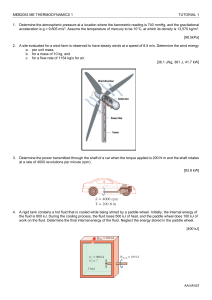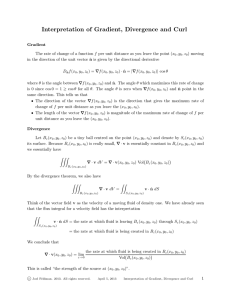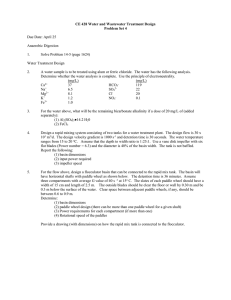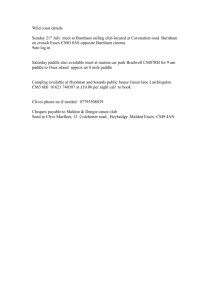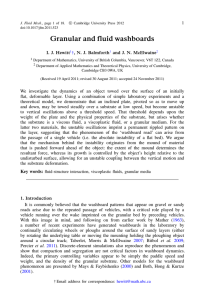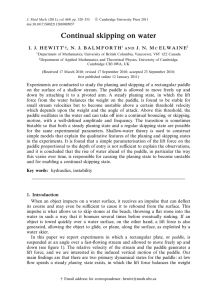Interpretation of Grad, Div and Curl
advertisement
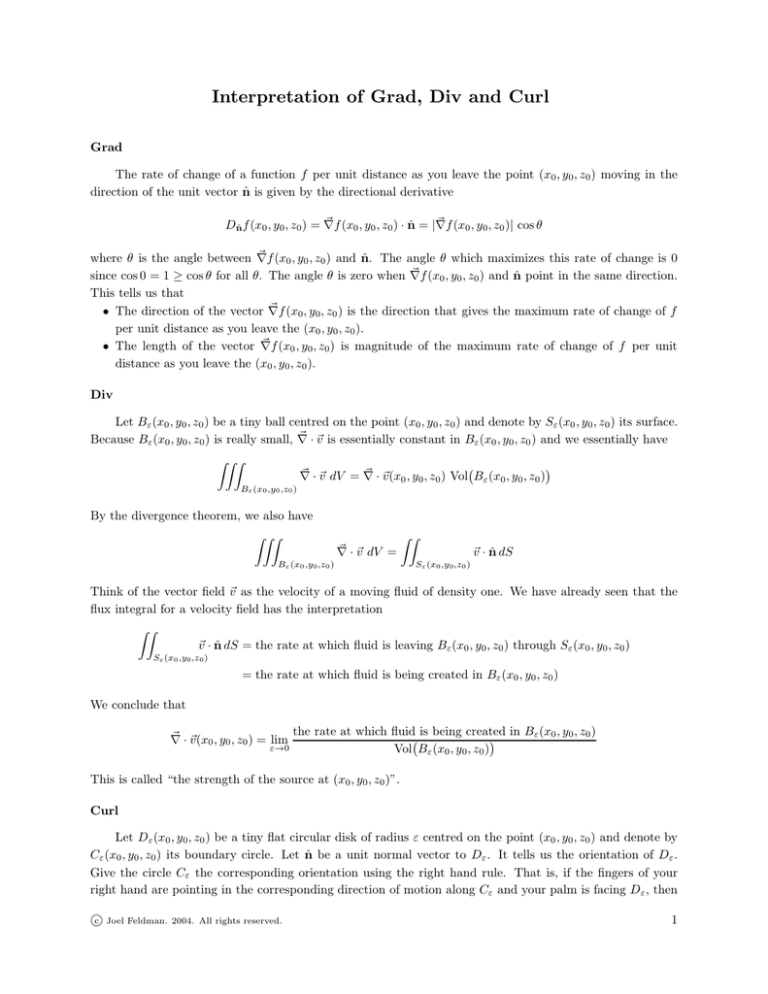
Interpretation of Grad, Div and Curl Grad The rate of change of a function f per unit distance as you leave the point (x0 , y0 , z0 ) moving in the direction of the unit vector n̂ is given by the directional derivative ~ (x0 , y0 , z0 ) · n̂ = |∇f ~ (x0 , y0 , z0 )| cos θ Dn̂ f (x0 , y0 , z0 ) = ∇f ~ (x0 , y0 , z0 ) and n̂. The angle θ which maximizes this rate of change is 0 where θ is the angle between ∇f ~ (x0 , y0 , z0 ) and n̂ point in the same direction. since cos 0 = 1 ≥ cos θ for all θ. The angle θ is zero when ∇f This tells us that ~ (x0 , y0 , z0 ) is the direction that gives the maximum rate of change of f • The direction of the vector ∇f per unit distance as you leave the (x0 , y0 , z0 ). ~ (x0 , y0 , z0 ) is magnitude of the maximum rate of change of f per unit • The length of the vector ∇f distance as you leave the (x0 , y0 , z0 ). Div Let Bε (x0 , y0 , z0 ) be a tiny ball centred on the point (x0 , y0 , z0 ) and denote by Sε (x0 , y0 , z0 ) its surface. ~ · ~v is essentially constant in Bε (x0 , y0 , z0 ) and we essentially have Because Bε (x0 , y0 , z0 ) is really small, ∇ ZZZ Bε (x0 ,y0 ,z0 ) ~ · ~v dV = ∇ ~ · ~v (x0 , y0 , z0 ) Vol Bε (x0 , y0 , z0 ) ∇ By the divergence theorem, we also have ZZZ ~ · ~v dV = ∇ Bε (x0 ,y0 ,z0 ) ZZ ~v · n̂ dS Sε (x0 ,y0 ,z0 ) Think of the vector field ~v as the velocity of a moving fluid of density one. We have already seen that the flux integral for a velocity field has the interpretation ZZ ~v · n̂ dS = the rate at which fluid is leaving Bε (x0 , y0 , z0 ) through Sε (x0 , y0 , z0 ) Sε (x0 ,y0 ,z0 ) = the rate at which fluid is being created in Bε (x0 , y0 , z0 ) We conclude that in Bε (x0 , y0 , z0 ) ~ · ~v (x0 , y0 , z0 ) = lim the rate at which fluid is being created ∇ ε→0 Vol Bε (x0 , y0 , z0 ) This is called “the strength of the source at (x0 , y0 , z0 )”. Curl Let Dε (x0 , y0 , z0 ) be a tiny flat circular disk of radius ε centred on the point (x0 , y0 , z0 ) and denote by Cε (x0 , y0 , z0 ) its boundary circle. Let n̂ be a unit normal vector to Dε . It tells us the orientation of Dε . Give the circle Cε the corresponding orientation using the right hand rule. That is, if the fingers of your right hand are pointing in the corresponding direction of motion along Cε and your palm is facing Dε , then c Joel Feldman. 2004. All rights reserved. 1 ~ ~v is essentially constant the thumb is pointing in the direction n̂. Because Dε (x0 , y0 , z0 ) is really small, ∇× n̂ Dε Cε on Dε (x0 , y0 , z0 ) and we essentially have ZZ Dε (x0 ,y0 ,z0 ) ~ ~v · n̂ dS = ∇× ~ ~v (x0 , y0 , z0 ) · n̂ Area Dε (x0 , y0 , z0 ) = πε2 ∇ ~ ×~v(x0 , y0 , z0 ) · n̂ ∇× By Stokes’ theorem, we also have ZZ ~ ~v · n̂ dS = ∇× Dε (x0 ,y0 ,z0 ) I ~v · d~r Cε (x0 ,y0 ,z0 ) H Again, think of the vector field ~v as the velocity of a moving fluid. Then Cε ~v · d~r is called the circulation of ~v around Cε . To measure the circulation experimentally, place a small paddle wheel in the fluid, with the axis of the paddle wheel pointing along n̂ and each of the paddles perpendicular to Cε and centred on Cε . n̂ ε Cε Each paddle moves tangentially to Cε . It would like to move with the same speed as the tangential speed ~v · t̂ (where t̂ is the forward pointing unit tangent vector to Cε at the location of the paddle) of the fluid at its location. But all paddles are rigidly fixed to the axle of the paddle wheel and so must all move with the same speed. That common speed will be the average value of ~v · t̂ around Cε . If ds represents an element of arc length of Cε , the average value of ~v · t̂ around Cε is I I 1 1 ~v · t̂ ds = 2πε ~v · d~r vT = 2πε Cε Cε since d~r has direction t̂ and length ds so that d~r = t̂ds. If the paddle wheel rotates at Ω radians per unit time, each paddle travels a distance Ωε (remember that ε is the radius of Cε ) per unit time. That is vT = Ωε. Combining all this info, I ZZ 1 1 ~ ×~v (x0 , y0 , z0 ) · n̂ ~ ~v · n̂ dS = 1 πε2 ∇ ~v · d~r = 2πε ∇× Ωε = vT = 2πε 2πε Cε Dε so that ~ ×~v(x0 , y0 , z0 ) · n̂ Ω = 12 ∇ ~ ×~v(x0 , y0 , z0 ) in any direction n̂ is twice the rate at which the paddle wheel turns when The component of ∇ ~ v (x0 , y0 , z0 ) it is put into the fluid at (x0 , y0 , z0 ) with its axle pointing in the direction n̂. The direction of ∇×~ ~ is the axle direction which gives maximum rate of rotation and the magnitude of ∇ ×~v (x0 , y0 , z0 ) is twice that maximum rate of rotation. c Joel Feldman. 2004. All rights reserved. 2
